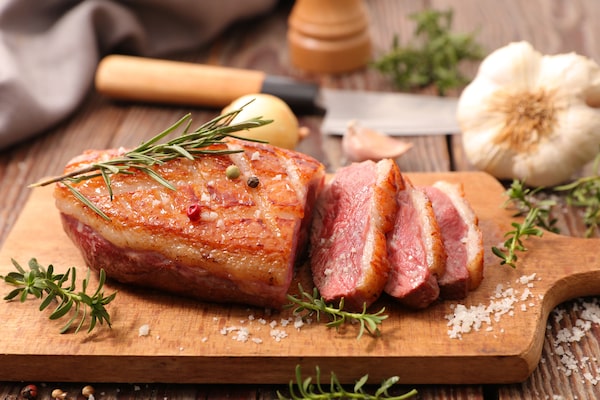
Muscovy duck breast is thick and meaty like a steak.margouillatphotos/iStockPhoto / Getty Images
Holiday celebrations make me think of my mother’s crispy-skinned roast duck, stuffed with chestnuts and apples; a glorious mahogany Peking duck, its skin wrapped in paper-thin pancakes and the meat stir-fried with vegetables; a soft, salty confit of duck leg, or a succulent pink duck breast. My favourite poultry, duck has always made my mouth water.
Many people are afraid to cook duck at home, though. They are worried about the large quantity of fat that is expelled, or that it will overcook and dry out. Both concerns are easy to handle.
Start by choosing the right kind of duck. The most readily available is the white Pekin duck. Thin-skinned and fatty, with pale meat, it makes excellent roast duck, if treated properly.
Cooking 101: Lucy Waverman decodes cooking techniques everyone can master
Muscovy is a different breed. The breasts are thick like a steak and taste meaty. They are usually sautéed or grilled and served rare or medium-rare. Cross hatch the skin before cooking to help the fat render. Muscovy legs are often made into confit. This is an ancient method of preservation. The legs are first salted and spiced, then immersed in fat and cooked at a low heat for several hours. They are then kept immersed in the fat for weeks. When ready to eat, roast them in a 400 F oven until the skin is crisped. Don’t roast a Muscovy duck; they are always dry.
Moulard is the duck lovers’ choice: large, meaty and a cross between the Peking and Muscovy varieties. Sadly they are hard to find in Canada.
I roast duck slowly in the manner of the late Paul Prudhomme, a famous Cajun chef. I recently roasted a five-pound Pekin duck at 250 F for three hours and then blasted at 375 F for 45 minutes. It had a skin so crisp it crackled in your mouth, tender juicy meat and all the duck fat was left sitting in the roasting pan not under the skin. Another bonus was a clean oven because the fat did not spatter.
To carve a duck, family style, cut it in quarters with kitchen shears. For a more elegant presentation, slice down between the thigh bone and the carcass and remove the leg and thigh in one piece. With the tip of a sharp knife, cut along the breast perpendicular to the breastbone and scrape it off the bones. Remove it along with the wings. If the duck is more than five pounds, it will serve four people; if smaller, two servings are all you’ll get.
There are other benefits to cooking your own duck, too. Duck fat makes the best roast potatoes. The skin, recrisped in the oven, makes a salad soar. The carcass makes a strong broth, and leftover duck meat, stir-fried with onion, carrot and ginger, makes a juicy spring roll or filling for a lettuce wrap.
With all these possibilities, how could you not want to try it?
Need some advice about kitchen life and entertaining? Send your questions to lwaverman@globeandmail.com.
Plan your weekend with our Good Taste newsletter, offering wine advice and reviews, recipes, restaurant news and more. Sign up today.
 Lucy Waverman
Lucy Waverman